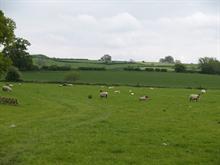How to Sow Seed and Establish a Pasture
 PREPARATION OF THE LAND FOR PASTURE
PREPARATION OF THE LAND FOR PASTUREGrass seed prefers a firm, level, weed-free seed bed. The land is first deeply tilled (preferably with a tined implement) to allow the soil to absorb as much rainfall as possible. It is then lightly tilled to conserve moisture but to remove young weeds.
Rolling may be necessary before and after sowing the seed. The final land surface should be made level in case the crop is harvested for hay from time to time. The plant furrow should be shallow. If it is deep, the rut quickly becomes filled with wind-blown soil which buries the grass seed too deeply for germination.
The soil should be analysed before sowing so that the fertility can be brought up to the required level if necessary. Phosphates should be added to the soil just before sowing. Grasses require 15ppm phosphate while legumes need 30ppm. Conventional farmers use superphosphate, but this is not an allowable input on certified organic farms. Some organic certifiers permit the use of rock phosphates.
The addition of legumes into the pasture mix will reduce the need for nitrogen in future years. To establish the pasture, however, it is important to fertilise as recommended by the soil analysis and by the organic certifying agent.
Many grass species are relatively resistant to soil acidity with the exception of some legumes (eg. lucerne and sainfoin). Table 1 shows which grass species tolerate acid conditions best.
The soil should be as moist as possible before sowing the seed. Summer pastures should be established from mid spring to mid summer (depending on the region) at a time that will coincide with reliable rainfall in the area. Early sowings of these pastures must be avoided because the soil temperature may be too low for fast germination. Late sowing may result in poor germination because of large swings in temperature.
Winter pastures should be established in autumn to take advantage of the swings in temperature. Rye-grass, for example, needs cold to germinate. However, the day time temperatures should not be too low. The aim is to establish a strong plant before the cold of winter sets in.
There are several ways to sow grass seed:
- broadcasting by hand - this requires some practice to get the correct coverage
- hand-held seeders - (more commonly used in the turf industry)
- seed drill - (wheat planter) can be used to plant seed in narrow rows
- special grass-seed planters - such as drum or sod seeders
- band seeders
- fertiliser spreaders - seed can be broadcast mechanically using tractor-mounted fertiliser spreaders
Germination
Most of the pasture grasses have a relatively long germination period. It is important to exercise patience and not plough up the land because it seems as though germination is poor. Even if the germination is poor, the grass seedlings that do emerge will seed themselves if allowed to grow out at the end of the season.
All the careful land preparation and seed selection will be worthless if the seed that is used is of poor quality with a low germination rate. Although certified seed is expensive, it is guaranteed to be of good quality and, what is more, free of grass and weed seeds. The initial expense will be repaid tenfold.
Weed Control
Weed control in pastures does differ from other field crops. Weeds are defined as a plant which the farmer did not plant. In field crops, all weeds are removed because they form competition for the cash crops. In pastures, certain weeds (such as Amaranthus) are beneficial to the grazing animals while others are not. Some weeds are poisonous to stock while other weeds have the potential to adversely affect the pasture.
There are two common attitudes to weeds in pastures. Some farmers see all weeds as being undesirable and spend a disproportionate amount of money on eradicating them. Others feel that pastures are inferior to cash crops and spend no money on eradiating weeds.
The most economic attitude is somewhere in between these two extremes. A few weed species that are palatable to stock are quite acceptable in a pasture.
Obviously, weed species should be eradicated if they are:
- aggressive
- not palatable
- can cause damage to the pasture
The two main methods used to eradicate weeds in organic pastures are:
- Mechanical Control - weed control can be done manually (by hand hoeing) or by tractor (eg. inter-row cultivation or slashing).
- Management Control - minimising the setting of seed by slashing or intensive grazing, by encouraging competitive species, and by providing soil conditions suitable for the desired species rather than the weed species.
Want to Learn More?
Use our FREE COURSE COUNSELLING SERVICE
connect with one of our horticulturists and get professional advice
on books, courses and working in horticulture click and submit the form
or
Check out online bookstore for dozens of titles written by our principal and staff:
www.acsbookshop.com